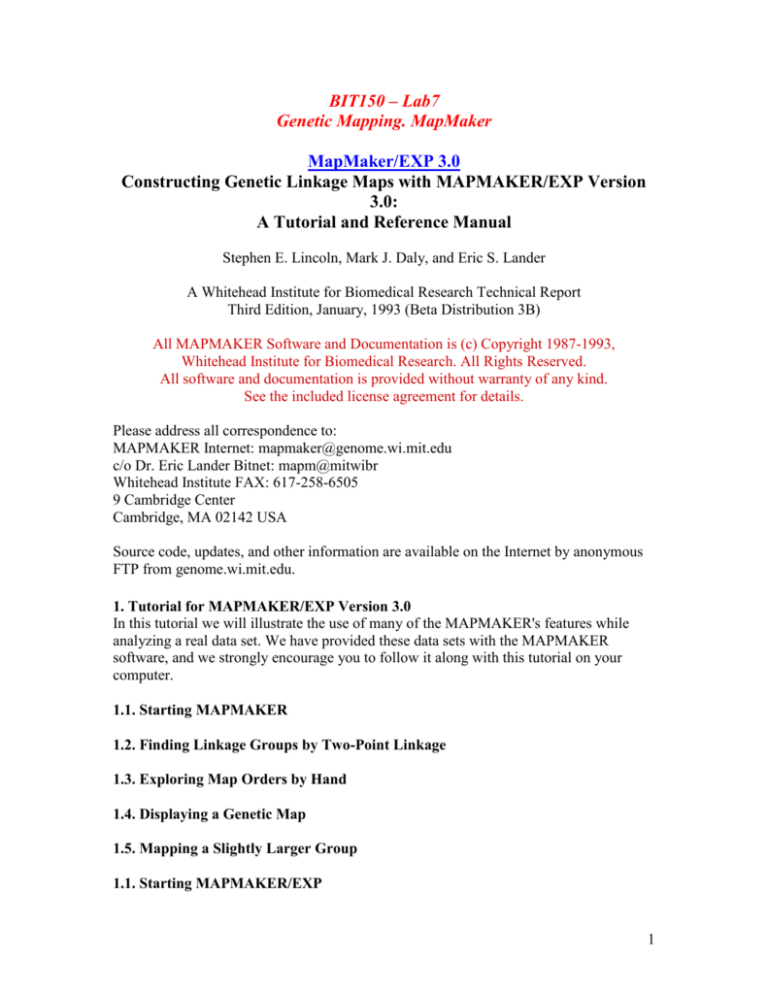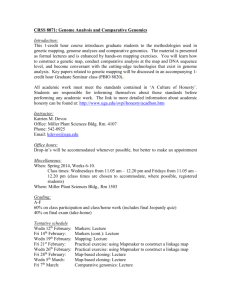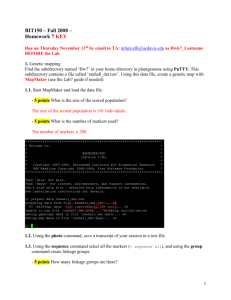
BIT150 – Lab7
Genetic Mapping. MapMaker
MapMaker/EXP 3.0
Constructing Genetic Linkage Maps with MAPMAKER/EXP Version
3.0:
A Tutorial and Reference Manual
Stephen E. Lincoln, Mark J. Daly, and Eric S. Lander
A Whitehead Institute for Biomedical Research Technical Report
Third Edition, January, 1993 (Beta Distribution 3B)
All MAPMAKER Software and Documentation is (c) Copyright 1987-1993,
Whitehead Institute for Biomedical Research. All Rights Reserved.
All software and documentation is provided without warranty of any kind.
See the included license agreement for details.
Please address all correspondence to:
MAPMAKER Internet: mapmaker@genome.wi.mit.edu
c/o Dr. Eric Lander Bitnet: mapm@mitwibr
Whitehead Institute FAX: 617-258-6505
9 Cambridge Center
Cambridge, MA 02142 USA
Source code, updates, and other information are available on the Internet by anonymous
FTP from genome.wi.mit.edu.
1. Tutorial for MAPMAKER/EXP Version 3.0
In this tutorial we will illustrate the use of many of the MAPMAKER's features while
analyzing a real data set. We have provided these data sets with the MAPMAKER
software, and we strongly encourage you to follow it along with this tutorial on your
computer.
1.1. Starting MAPMAKER
1.2. Finding Linkage Groups by Two-Point Linkage
1.3. Exploring Map Orders by Hand
1.4. Displaying a Genetic Map
1.5. Mapping a Slightly Larger Group
1.1. Starting MAPMAKER/EXP
1
1.1.1. Exactly how you start MAPMAKER depends on how it was installed in your
system (see the Installation Guide included with MAPMAKER for details).
Usually, you will want to first go into the directory which contains the data files you
want to analyze (using the cd command):
> cd Lab7
Then, you can start MAPMAKER by simply typing:
> mapmaker
When MAPMAKER starts, you will first see its start-up banner and a prompt 1> for the
first command:
1.1.2. The first step in almost every MAPMAKER session is to prepare and load a data
file for the analysis. If you are starting out an analysis on a new data set, or if you have
modified the raw data in an existing data set, you will do this using MAPMAKER's
prepare data command. If instead you are resuming an analysis of a particular
(unmodified) data set, you may use the load data command, which preserves many of the
results from your previous session. Because we are just starting out, we will use
MAPMAKER's prepare data command to load our sample data file sample.raw,
located into the Lab7 directory:
> prepare data sample.raw
2
From this file MAPMAKER extracts the type of cross, the number of scored progeny, the
number of used markers, and the genotype for each marker in each individual (if
available). Other information may be present in the data files, such as quantitative trait
data and pre-computed linkage results.
1.1.3. Before performing any analysis, we now instruct MAPMAKER to save a
transcript of this session in a text file for later reference. Using the photo command, we
start a transcript named tutorial.out. Note that if the file already exists, MAPMAKER
appends a new output to this file.
> photo tutorial.out
1.2. Finding Linkage Groups by Two-Point Linkage
1.2.1. Want to find linkage groups by performing a classical two-point, or pairwise,
linkage analysis on our data file. To do this we need to tell MAPMAKER which loci
we wish to consider in our two-point analysis, which we do by using MAPMAKER's
sequence command.
MAPMAKER is told which loci (and, in some cases, which order for those loci) any
following analysis command should consider. Since almost all of MAPMAKER's
analysis commands use the current sequence to indicate which loci they should consider,
you will find that the sequence command must be entered before performing almost
any analysis. The sequence of loci that is in use remains unchanged until you use the
sequence command again to change it.
In this two-point analysis we want MAPMAKER to examine all 12 of the loci present our
sample data file. Thus, we now type:
3
> sequence 1 2 3 4 5 6 7 8 9 10 11 12
Note that for two-point analysis, the order in which the loci are listed is not
important.
1.2.2. We then use MAPMAKER's group command, instructing the program to divide
the loci into linkage groups. To determine whether any two markers (loci) are linked,
MAPMAKER calculates the maximum-likelihood distance and corresponding LOD score
between the two markers. If the LOD score is greater than some threshold, and if the
distance is less than some other threshold, then the two markers will be considered
linked. By default, the LOD threshold is 3.0, and the distance threshold is 80 Haldane
cM.
For the purpose of finding linkage groups, MAPMAKER considers linkage transitive.
That is, if marker A is linked to marker B, and if B is linked to C, then A, B, and C will
be included in the same linkage group.
Type the group command:
> group
As you see, MAPMAKER has divided the 12 loci into 2 linkage groups, named as
group1 and group2. Moreover, there is no unlinked marker in this data file.
1.3. Exploring Map Orders by Hand
To determine the most likely order of the markers within a linkage group, we could
imagine using the following simple procedure. For each possible order of markers within
that group, we calculate the maximum-likelihood map (e.g. the distances between all
markers), and the corresponding likelihood of the map. We then compare these
likelihoods and choose the most likely order as the answer. This type of exhaustive
analysis may be performed using MAPMAKER's compare command.
In practice however, this sort of exhaustive analysis is not practical for even medium
sized groups: a group of N markers has N!/2 possible orders, a number which becomes
unwieldy (for most computers) when N gets to be more than 10. (In practice, one needs to
4
order subsets of the linkage group and then overlap those subsets, mapping any remaining
markers relative to those already mapped).
Because the linkage groups (group 1 and group2) we are working with are small, we can
use a fully exhaustive analysis. We will start with linkage group1. To do an exhaustive
analysis for marker order within linkage group1 , we first need to change
MAPMAKER's sequence to the one of group1:
> sequence {1 2 3 5 7}
Again, the order of markers here does not matter. Here, the curly brackets indicate
that the order of the markers contained within them is unknown, and thus that all
possible orders between markers need to be considered.
We then type the compare command, instructing MAPMAKER to compute the
maximum-likelihood map for each possible order of markers, and to report the orders
sorted by the likelihoods of their maps.
> compare
5
Note that while MAPMAKER examines all possible orders of markers, only the 20 most
likely ones are reported by default. For each of these 20 orders, MAPMAKER displays
the log-likelihood of each map relative to the best likelihood found. Note that the smaller
the log-likelihood of a map, the more probable that the order of markers is the one
provided by that map. Thus the best first order of markers: 1 3 2 5 7 is indicated as
having a relative log-likelihood of 0.00. The second order of markers: 3 1 2 5 7 is
significantly less likely than the first one, having a relative log-likelihood of -6.0. Said in
a different way, the best first order of markers for this linkage group1 is supported by an
odds ratio of 1,000,000:1 (10 to the 6th power to one), over any other order. We consider
this as a good evidence that we have found the right order.
1.4. Displaying a Genetic Map
When we used the compare command previously, MAPMAKER calculated the map
distances and log-likelihoods for each of the 60 possible orders of markers (5 markers =
(5*4*3*2*1)/2 = 60). The compare command, however, only reports the relative loglikelihoods, and afterwards forgets the map distances. To actually display the genetic
distances we must instead use the map command.
The map command instructs MAPMAKER to calculate the maximum-likelihood map of
each order specified in a sequence. If the sequence specifies more than one order (for
example, the sequence {1 2 3 5 7} specifies 60 different orders) then the maximumlikelihood maps for all specified orders will be calculated and displayed.
Because we found one order of this group to be much more likely than any other, we
probably only care to see the map distances for this single order.
6
First, we set MAPMAKER's sequence, putting the markers of linkage group1 in their best
order (no curly brackets):
> sequence 1 3 2 5 7
Next, we simply use the map command to display this order's maximum likelihood map:
> map
As you can see, the distances between neighboring markers are displayed. Note however,
that these distances may be considerably different than the two-point distances between
those markers: This is because MAPMAKER's so-called multipoint analysis facility can
take into account much more information, such as flanking marker genotypes and some
amount of missing data. This is precisely the reason that we use multipoint analysis rather
than two point analysis to order markers: Because more data is taken into account, you
have a smaller chance of making a mistake.
1.5. Mapping a Slightly Larger Group
1.5.1. We will now generate a map for linkage group2. We can see how much data is
available for the markers in this group if we set MAPMAKER's sequence
appropriately and use MAPMAKER's list loci command.
> sequence 4 6 8 9 10 11 12
> list loci
7
MAPMAKER prints a list of loci, showing each marker by both its MAPMAKERassigned number as well as its name in the data file. For each marker, MAPMAKER
prints the number of informative progeny (out of the 333 in the data set), and the type of
scoring. In this case all loci have been scored using co-dominant (codom) markers (e.g.
RFLP-like genotypes in an F2 intercross), although clearly markers 4 and 6 are the least
informative.
1.5.2. To also look for markers which may be too close, use MAPMAKER's lod table
command.
> lod table
8
MAPMAKER prints both the distance and LOD score between all pairs of markers in the
current sequence.
1.5.3. To generate a map from the marker in this linkage group we will again do an
exhaustive search.
First, set the sequence using curly brackets so the loci order is undefined:
> sequence {4 6 8 9 10 11 12}
1.5.4. Then, use the compare command again to determine the most probable order. This
will compare the 2520 possible orders, although the first 20 most likely will be reported:
> compare
9
According to the lod-liklihood values, the most probable order for linkage group2 would
be 4 11 8 12 9 6 10.
Set the current sequence to the most probable order:
> sequence 4 11 8 12 9 6 10
1.5.5. Then map the loci:
> map
10
To exit MapMaker, type:
> quit
11





